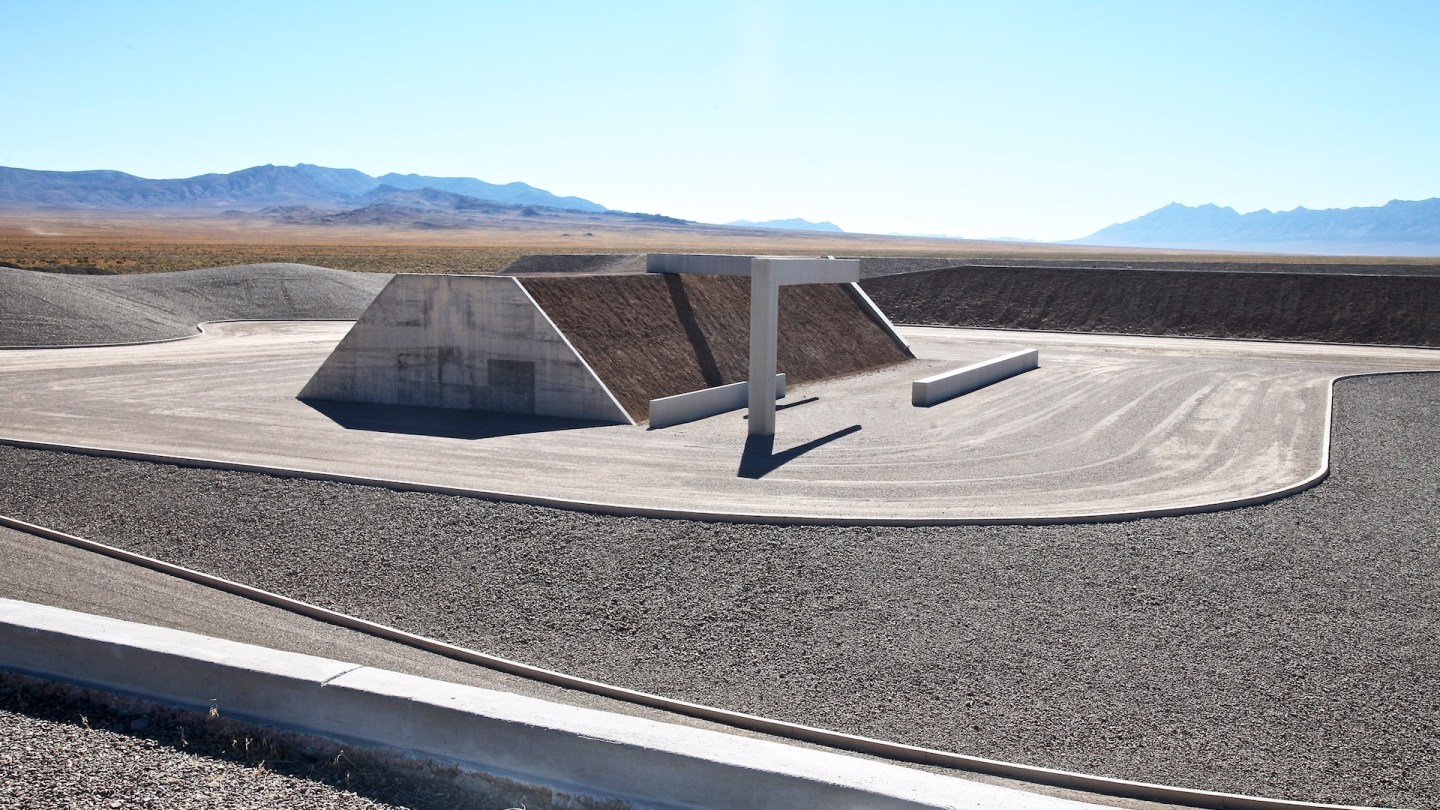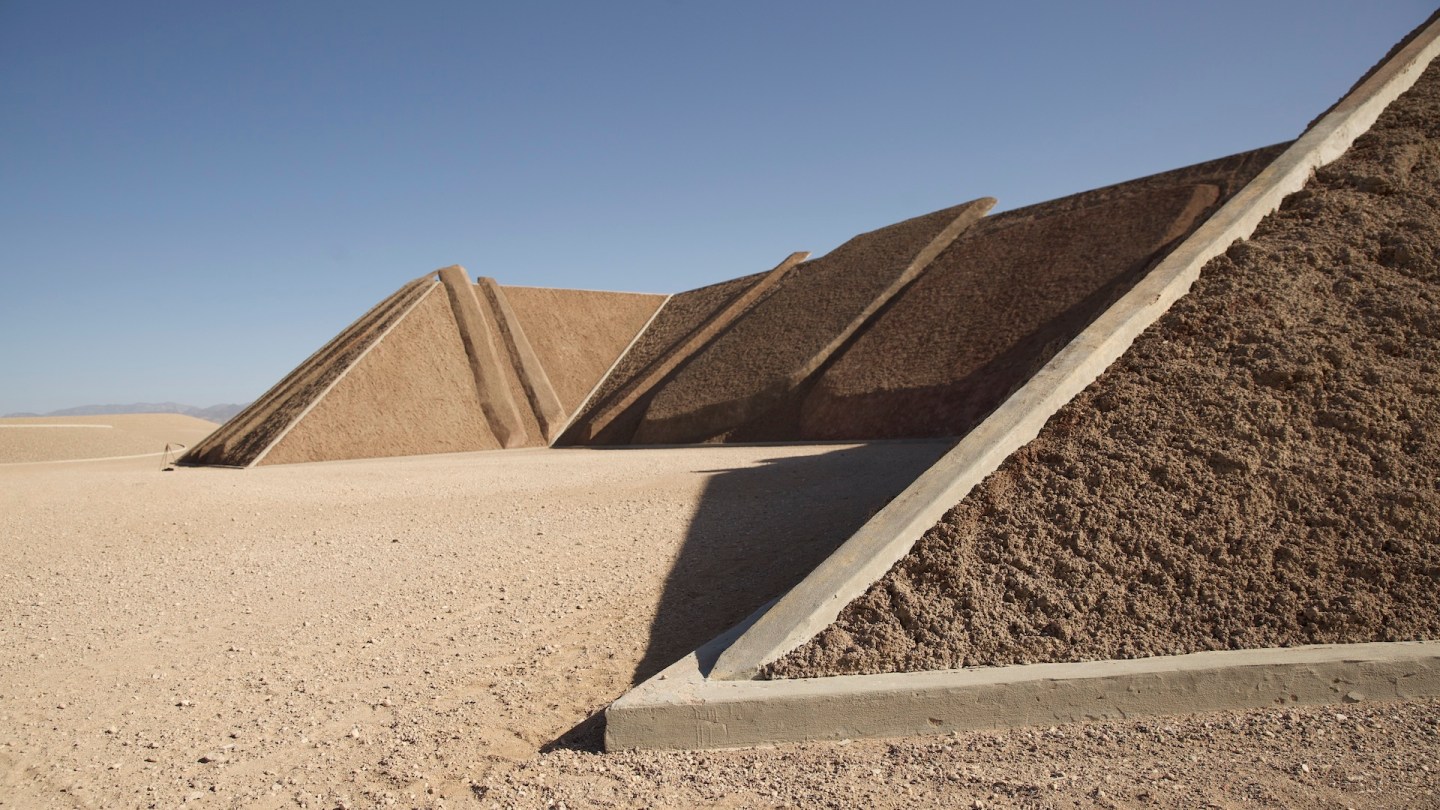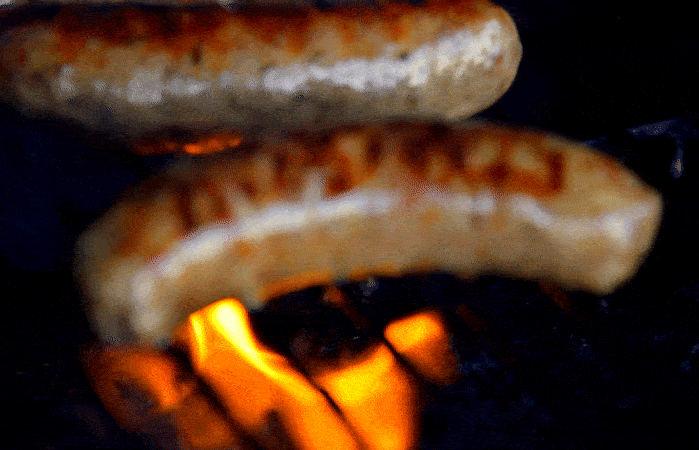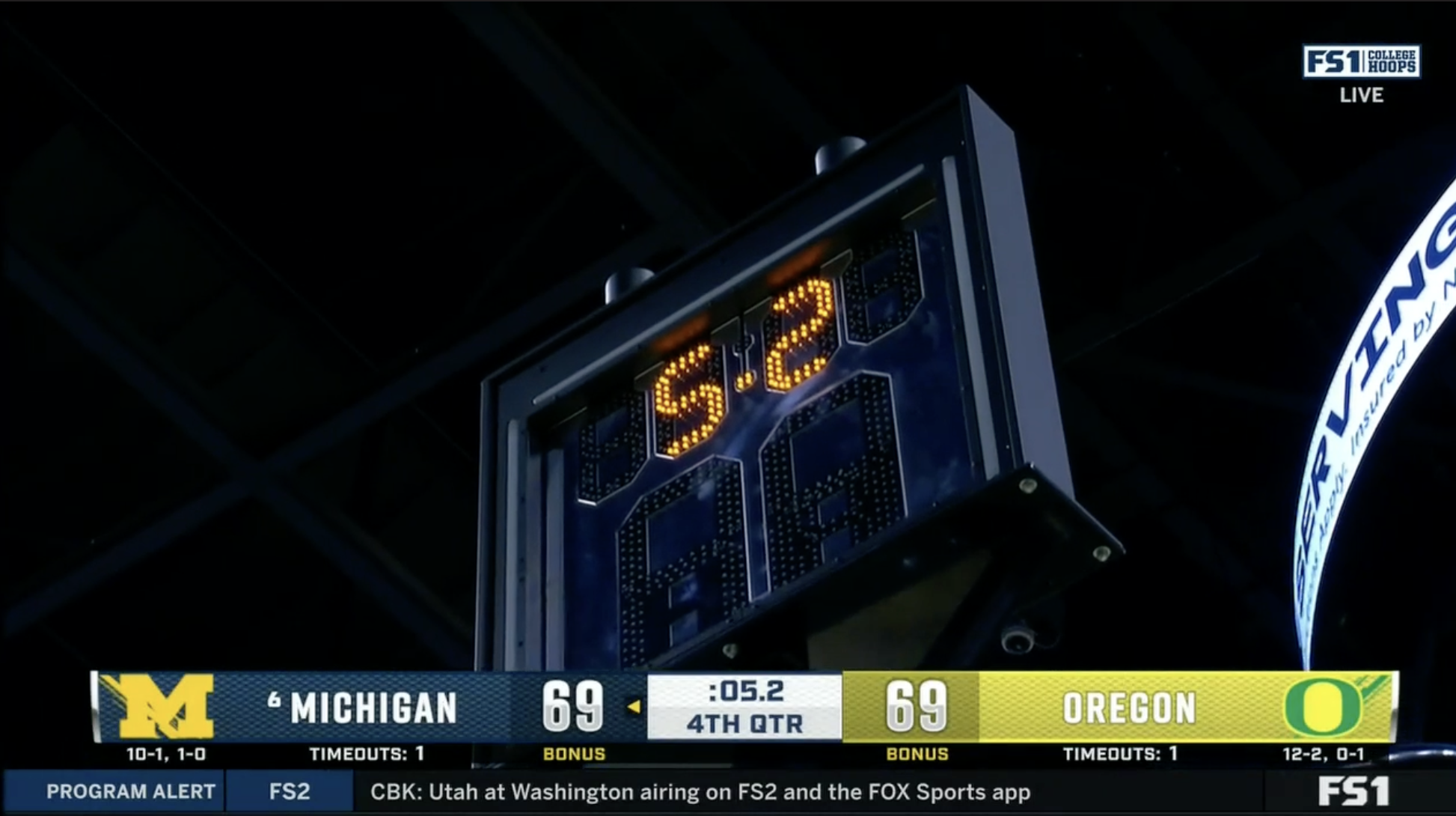Alamo, Nev. is a town of fewer than 1,500 people that sits about 100 miles northwest of Las Vegas. The drive out there is typical of most in the southwest: once you leave the city, you follow the gentle curve of the highway, make a single turn, then keep straight until your eyes bleed. It’s November now, but I’d been trying to see Michael Heizer’s City project for months. The sculpture, or artwork, or installation (I’ve heard it described as all three) is run by the non-profit Triple Aught Foundation, which includes Heizer and other artists on its board. Eventually, after so much rescheduling, it seemed like I was never actually going to make it out there and City, as it exists for most people, would remain a kind of desert curio, experienced through aerial photography and the limited testimony of the lucky few who made it through. At $150 per person, tickets to City aren't the most affordable. The journey there and back requires a full day for travel, and the waiting list is long. Having now seen the gargantuan land work, and knowing the actual viewing experience takes three hours, my harrumphing about not going when I was originally scheduled, back in the thick of July’s searing heat, seems funny in retrospect.
Michael Heizer’s shadow is long. The land artist from Berkeley, famous for his large-scale, earth-moving work, had been hacking away at City in Nevada’s Lincoln County for 24 years by the time I was born. He started the project when he was the age I am now. I’ve not seen much land art that’s known outside the bounds of Las Vegas, but I’ve been hearing Heizer’s name most of my life, no matter where I’ve gone. Double Negative, his 1969 work consisting of a long trench dug out of the Moapa Valley in Overton, about 150 miles south of City, got mentioned a fair amount when people tried to justify the legitimacy of interesting art carved from the desert itself.
Thing is, Heizer was never talked about like a local. His interventions always carried with them the implication that he was coming at things from an adopted perspective. His defenders have termed him an outsider, his critics an interloper, all of it more fodder for Heizer himself, who prefers his self-stated provocations cryptic or proudly egotistical. “There’s no understanding of my work,” he once said. There is no guided tour or predetermined route at City, which leaves visitors to decide for themselves how to experience the project, and what to make of it.
Visiting groups to City are capped at six people, led by a driver who takes you up from Alamo to Garden Valley, where the artwork shares a road with a private ranch. Our driver was a third-generation Alamo resident named Ed Higbee, a tall, affable 69-year-old I’d read about in a 2020 dispatch from the installation and with whom I would readily entrust my life. The guidelines for getting to City mandated arrival times down to the minute and my girlfriend and I, along with four guys from the Midwest, showed up too early because we had no idea how strict those guidelines were. The Triple Aught Foundation’s office is down Broadway, which cuts through a small neighborhood, a few shops, an RV park, a post office, a Mormon church, and a high school football field. The office shares its white-painted wooden building with a pharmacy.
Ed left an unexpected but lasting impression on my trip. When I thought of Heizer and his peers—workers of industrial materials endeavoring to shape new concepts of what it means to make American art—I saw a rarefied milieu. I thought of art galleries and then, because Heizer and his lot avowed such pointed rejections of stifling New York City elitism, the rural landscapes these artists traded the city for—open expanses, the plains and the desert. I never thought of people. Indeed, City’s very name, its placement, and its spareness situate people as an external component. But when I think about City now, I first think of Ed.
“I met Mike in my senior year of high school,” he told us. Apparently, Ed’s grandfather helped Heizer find the plot of land that became City, no mean feat given how rare it is to find private property in the Nevada countryside. A dam had been built to capture the runoff from snow in the mountains just beyond City, but the dam washed out and the land eventually got bought by Heizer. Ed’s stories told us what cursory research couldn’t, the minutiae of small-town desert life, the tension between the isolation of the country and the ever-present hand of the government. Ed told us about the ranchers whose fields and cattle succeeded because of readily-available city money and their neighbors, who held onto fallow crops and rusting equipment. He told us about the local haggling necessary to wrest small parcels of land from federal hands. He told us well-worn settler stories of a well-kept community open to the transience of truckers, outdoor recreationalists, and artists like Heizer.
Before setting out in Triple Aught’s large, white SUV, Ed showed us satellite images of our route on a tablet, pinching his fingers over nearby areas of interest: a nuclear test site pockmarked with gigantic holes, three natural springs that have made the surrounding landscape into wetlands, Area 51. In fifth grade, Ed had lived one year in Las Vegas when his dad worked as a security guard downtown. Other than that, he’s worked and raised seven children in Alamo, which he says hasn’t changed all that much. “I was top 13 in my class because that’s all there was when I was going,” Ed joked. It seemed a well-worn anecdote, but it worked on me and my girlfriend. As for our other companions, it seemed they found Ed’s rural affability a bit quaint; at least they tipped him at the end.

The hour-and-a-half it takes to get to the site is mostly spent on a dirt road that winds through open range. Cattle graze in the distance, the valley crowded with white sagebrush, trees, the odd large puddle of standing water (this year marked, in many places in the state, the end of a years-long drought), and countless anthills. Ed said an animal enthusiast on a previous trip noticed the hills belonged to carpenter ants because of the characteristic empty circle surrounding them. The ants clear out brush and other debris and use the materials within the hill itself, which seemed a tidy illustration of Heizer’s project. Apart from concrete, City’s components are made from the surrounding landscape, an anthill without a colony.
If you come from most any southwestern suburb, Heizer’s work looks a lot like an unfinished neighborhood or freeway underpass. The project is a mile and a quarter long and almost a mile wide. It undulates in sloping mounds and steady downgrades, with curved shapes made from lines of concrete. The mounds, perfectly round, along with the pathways that soar between the three main sculptures, are made from pulverized rock from the surrounding area. You can’t see the whole of City from any vantage point within it. A hill or a depression will obscure your line of sight and you’re left with the feeling of being sunk into the earth.
There are three Complexes, each named simply by number, spread across the project. Complex 1 resembles a triangular concrete bunker fronted by an illusion. At the top of the structure, nearly its roof, are three horizontal bars that, from a distance and head on, look like a single unbroken piece of concrete. Come close and you see that not only does each piece not connect, but that they aren’t even on the same plane. Because an integral aspect of City is the way that the sun changes the shadows of each structure ( hence the reason for the three-hour visitation time), Complex 1’s shape only becomes more complicated, the illusion of wholeness maintained by the three bars simultaneously broken by the individual shadows of each bar arcing on the structure beneath it. The effect is beautiful and disorienting.

Complex 2 sits just next to 1, a series of massive slabs or planks of concrete mixed with a reddish-brownish substance made to match the natural oxidized color of the mountains nearby. These slabs, each at least 50 feet long, rest against a slope that encompasses Complex 1. On the underside of each slab, impressions of wood grain can be seen from where each piece was laid flat on a table. This effect runs throughout several pieces in City, concrete structures imbued with the ghost of nature, as if the pieces were actually organic.
At the opposite end of City sits Complex 3, a courtyard of large concrete triangles, squares, and sunken prisms, each grouped in trios of varying sizes and depths. One massive square, which leans at a 45-degree angle against a wall that makes up the back of Complex 3, hides behind it several puddles of coyote and bird shit. Another large square that stands upright next to it is also lined with white streaks that look like rain trails. The third square, laid on its face, is virtually pristine. Complex 3, a kind of minimalist playground, had the greatest effect on me in part because the quality of shadow there was most dramatic. Three tall concrete triangles of similar size and distance away from each other face west like sundials, the shadows from each triangle’s edge creating a framing effect on the neighboring sculpture. The far wall where the squares huddle bounces sound around the entire piece. More so than City’s other components, here is where the sense of abandonment and industrial vacancy comes to bear.
Heizer wants visitors to make up their own minds about his work and part of that entails wrestling with whether or not the most obvious conclusions are actually red herrings. Abandonment, or evocation of it, is part of City—the unnaturally manicured, perfect lines, the desert as seen from a distance, a place so dead there can be no change. But up close, there are signs of the desert’s encroachment: weeds sprouting from gravel paths, spider webs across almost every surface, lines of moss growing between cracks in the concrete, the aforementioned bird shit. The structures themselves, the monoliths of Complex 1, 2, and 3, are impressive for their starkness, their utter completeness. They seem dropped from the sky. But it’s also impossible not to think of the upkeep of City, the crews who come in before every visitation to repave the pathways, to pull weeds, to scrape away the fingerprints of whatever nature has in store on that particular day. Because City took 50 years to complete, the reminder of its very construction is also part of experiencing it.
Heizer’s project of going into the middle of nowhere, an endeavor which he claimed had no forethought to it, situates the desert as a place of nothingness and monotony. Coming upon City after all those miles on the road seems like it’s meant to startle. More interesting is the idea of City as a failed attempt to outdo the grandeur of the beauty that it sits in, to hold the elements at bay, to last. In a long New Yorker profile, Heizer said, “My good friend Richard Serra is building out of military-grade steel. That stuff will all get melted down. Why do I think that? Incans, Olmecs, Aztecs—their finest works of art were all pillaged, razed, broken apart, and their gold was melted down. When they come out here to fuck my ‘City’ sculpture up, they’ll realize it takes more energy to wreck it than it’s worth.”
Except there’s not much energy needed to make an artwork naked to the elements begin to crack. City belongs more to the non-human creatures of Garden Valley that leave their marks on it—ravens, owls, ants, scorpions, coyotes. Heizer may have conceived of City himself, but Heizer doesn’t live in Lincoln County anymore and his work is maintained by unseen crews who are as much artists themselves as they are custodians. The land around City is not some random patch of ground, but a federally protected landmark that received its status due to Heizer’s insistent lobbying. It’s clear, just from the location, that Heizer loves the desert, and City’s lasting virtue is staging a prolonged encounter between the land and its visitors. But, as Rebecca Uhill and Ana María Leó wrote for Hyperallergic, the artwork also “serves as an apparatus of two different regulatory enterprises: on the one hand, a culturally designated space of landscape preservation, and on the other, a regulated art-world experience of manifest scarcity.” Heizer pays ambivalent lip service to the indigenous inspirations behind City, more as a brag through comparison, but his intentions are rooted firmly in the kind of manifest destiny fantasy of the southwest as a romantic, winner-take-all inheritance.
Dave Hickey, the late, vaunted art critic, described the Nevada desert thusly: “There are small mountains and taller mountains that are smoothed off here and there, by wind and water, to resemble mesas. There are tilts, cliffs, canyons, and meadows. There are ridges winding among the mountains and washes running north and south. There is virtually no flora beyond desert shrubbery, and thus, from the ground, there is no visible sense of scale or distance. There is only big space—’cowboy Afghanistan,’ we called it when I lived in Las Vegas—a dog whistle for crazy people with their hair on fire and their heads full of wild ideas.”

Hickey was from Texas and not a stranger to the desert. But his signature brand of affected literary terseness, which often extends to an “American” masculine style of writing, doesn’t hide the fact that he says much the same thing that people have been conditioned to think about the desert: it’s big, it’s stark, you can see the passage of time in the hills, and all of this signals something about the frontier. The desert is real and it is vast, but it is also what you make of it. Such a characterization is one, as a person who has lived here all my life, that I’ve always had a very difficult time believing.
It may also be the fact that Hickey terms Heizer and his peers—Ellsworth Kelly, Robert Indiana, Ed Ruscha, Agnes Martin—as part of a “diaspora” of artists, which represents another feature of this kind of writing: if the sentence is nice enough, you can make words mean whatever you want them to. That there is the brief, othered thrill of a cohesive group described as a displaced people does the work of illustrating Hickey’s point (one tacitly shared by Heizer) and also making him sound much like the other vastness-obsessed intellectuals who try to pretty up the desert with effortful poeticism. It never occurs to Hickey, or Heizer, because why would it, that in what is now Lincoln County, there actually were displaced people, or that the artistic flight from New York that took place in the 1970s does not represent anything like exile, rather a difference of opinion and social preference.
Of course, Hickey likely got a more exclusive view than most visitors, even press. His essay on City was published by Gagosian Quarterly, of art mogul Larry Gagosian, who represents Heizer, so one need not think too hard about why Hickey’s experience was different. But it does mean that, at least for as long as City is operated in the current manner by Triple Aught, Hickey wasn’t writing about a universal experience because that experience is necessarily shared with other people. Or maybe it’s that other people don’t figure as largely in the estimation of art. I felt the “catalog of ambition” of Heizer’s work in City, but ambition is often overrated. I felt the pull of the desert itself in my time in Garden Valley, the sea of white sagebrush beneath the diffusing contrails of jets performing training maneuvers drawing my eye away from Heizer’s precise, long-simmering creations. More, I felt, by the end, that I wanted to be back with Ed Higbee in the white SUV, shooting the shit, and watching the sun set.







